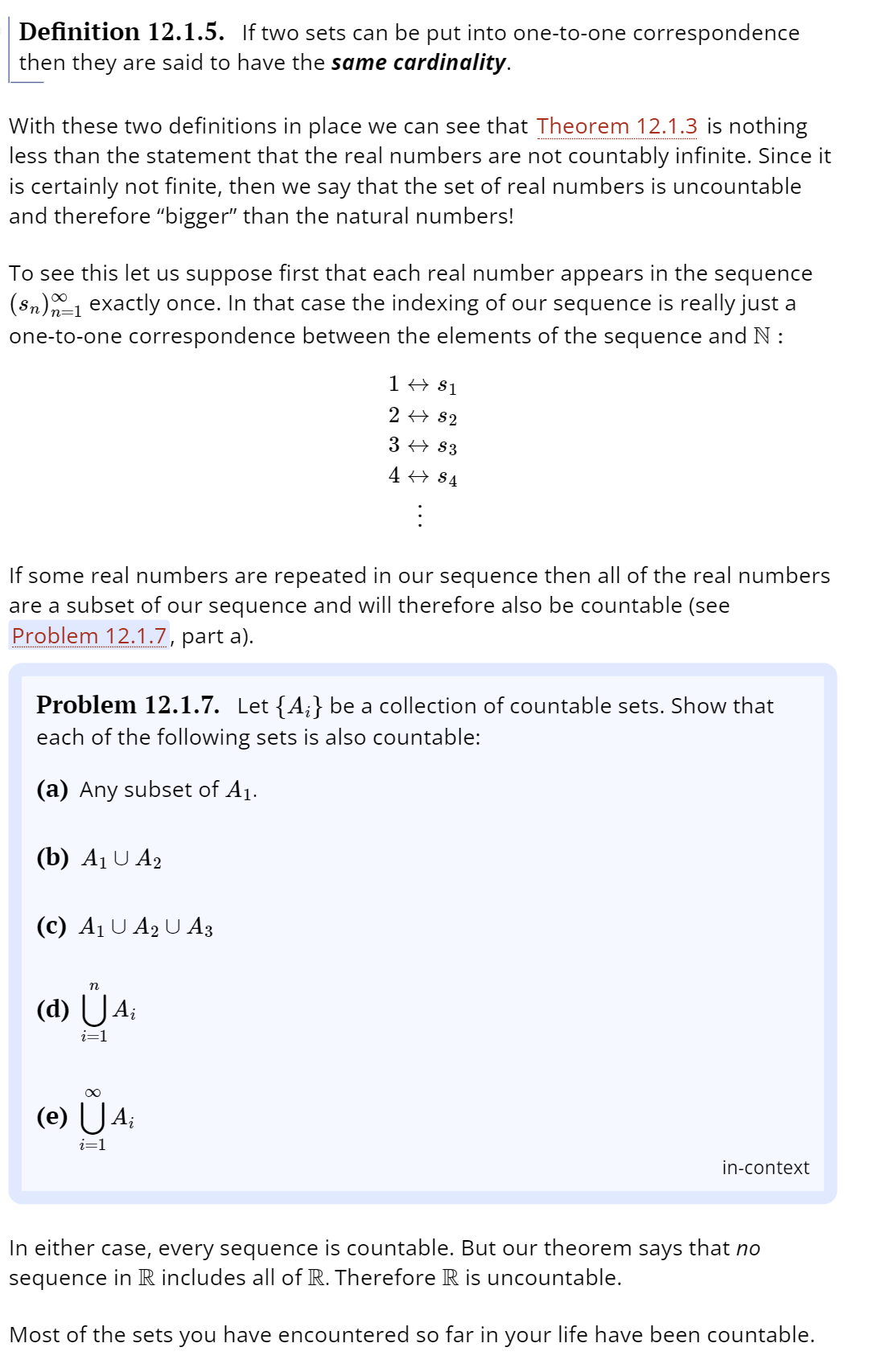Definition 12.1.5. If two sets can be put into one-to-one correspondence then they are said to have the same cardinality. With these two definitions in place we can see that Theorem 12.1.3 is nothing less than the statement that the real numbers are not countably infinite. Since it is certainly not finite, then we say that the set of real numbers is uncountable and therefore "bigger" than the natural numbers! To see this let us suppose first that each real number appears in the sequence (sn)1 exactly once. In that case the indexing of our sequence is really just a one-to-one correspondence between the elements of the sequence and N : 1 → $1 2 + S2 3 + S3 4 → $4 If some real numbers are repeated in our sequence then all of the real numbers are a subset of our sequence and will therefore also be countable (see Problem 12.1.7, part a). Problem 12.1.7. Let {A;} be a collection of countable sets. Show that each of the following sets is also countable: (a) Any subset of A1. (b) A1 U A2 (c) A1 U A2 U A3 (d) UA; i=1 (e) UA; i=1 in-context In either case, every sequence is countable. But our theorem says that no sequence in R includes all of R. Therefore R is uncountable. Most of the sets you have encountered so far in your life have been countable.
Definition 12.1.5. If two sets can be put into one-to-one correspondence then they are said to have the same cardinality. With these two definitions in place we can see that Theorem 12.1.3 is nothing less than the statement that the real numbers are not countably infinite. Since it is certainly not finite, then we say that the set of real numbers is uncountable and therefore "bigger" than the natural numbers! To see this let us suppose first that each real number appears in the sequence (sn)1 exactly once. In that case the indexing of our sequence is really just a one-to-one correspondence between the elements of the sequence and N : 1 → $1 2 + S2 3 + S3 4 → $4 If some real numbers are repeated in our sequence then all of the real numbers are a subset of our sequence and will therefore also be countable (see Problem 12.1.7, part a). Problem 12.1.7. Let {A;} be a collection of countable sets. Show that each of the following sets is also countable: (a) Any subset of A1. (b) A1 U A2 (c) A1 U A2 U A3 (d) UA; i=1 (e) UA; i=1 in-context In either case, every sequence is countable. But our theorem says that no sequence in R includes all of R. Therefore R is uncountable. Most of the sets you have encountered so far in your life have been countable.
Linear Algebra: A Modern Introduction
4th Edition
ISBN:9781285463247
Author:David Poole
Publisher:David Poole
Chapter2: Systems Of Linear Equations
Section2.4: Applications
Problem 33EQ
Related questions
Question
100%

Transcribed Image Text:Definition 12.1.5. If two sets can be put into one-to-one correspondence
then they are said to have the same cardinality.
With these two definitions in place we can see that Theorem 12.1.3 is nothing
less than the statement that the real numbers are not countably infinite. Since it
is certainly not finite, then we say that the set of real numbers is uncountable
and therefore "bigger" than the natural numbers!
To see this let us suppose first that each real number appears in the sequence
(sn)1 exactly once. In that case the indexing of our sequence is really just a
one-to-one correspondence between the elements of the sequence and N :
1 → $1
2 + S2
3 + S3
4 → $4
If some real numbers are repeated in our sequence then all of the real numbers
are a subset of our sequence and will therefore also be countable (see
Problem 12.1.7, part a).
Problem 12.1.7. Let {A;} be a collection of countable sets. Show that
each of the following sets is also countable:
(a) Any subset of A1.
(b) A1 U A2
(c) A1 U A2 U A3
(d) UA;
i=1
(e) UA;
i=1
in-context
In either case, every sequence is countable. But our theorem says that no
sequence in R includes all of R. Therefore R is uncountable.
Most of the sets you have encountered so far in your life have been countable.
Expert Solution
This question has been solved!
Explore an expertly crafted, step-by-step solution for a thorough understanding of key concepts.
Step by step
Solved in 3 steps with 3 images

Recommended textbooks for you

Linear Algebra: A Modern Introduction
Algebra
ISBN:
9781285463247
Author:
David Poole
Publisher:
Cengage Learning

Elements Of Modern Algebra
Algebra
ISBN:
9781285463230
Author:
Gilbert, Linda, Jimmie
Publisher:
Cengage Learning,

Elementary Geometry For College Students, 7e
Geometry
ISBN:
9781337614085
Author:
Alexander, Daniel C.; Koeberlein, Geralyn M.
Publisher:
Cengage,

Linear Algebra: A Modern Introduction
Algebra
ISBN:
9781285463247
Author:
David Poole
Publisher:
Cengage Learning

Elements Of Modern Algebra
Algebra
ISBN:
9781285463230
Author:
Gilbert, Linda, Jimmie
Publisher:
Cengage Learning,

Elementary Geometry For College Students, 7e
Geometry
ISBN:
9781337614085
Author:
Alexander, Daniel C.; Koeberlein, Geralyn M.
Publisher:
Cengage,

Elementary Geometry for College Students
Geometry
ISBN:
9781285195698
Author:
Daniel C. Alexander, Geralyn M. Koeberlein
Publisher:
Cengage Learning